
Which of the following compounds is optically active?
A. $\text{C}{{\text{H}}_{3}}\text{C}{{\text{H}}_{\text{2}}}\text{COOH}$
B. $\text{HOOC - C}{{\text{H}}_{\text{2}}}\text{- COOH}$
C. $\text{C}{{\text{H}}_{\text{3}}}\text{CH(OH)COOH}$
D. $\text{C}{{\text{l}}_{\text{2}}}\text{CHCOOH}$
Answer
584.4k+ views
Hint: A substance which has optical activity, is a substance which rotates the plane of plane polarized light. To know whether a compound is optical active we need to consider the property of chirality. By chirality we mean a carbon having 4 different groups attached to it. If we find any chiral centre, then that compound is optically active. With this approach, we can find out which of the compounds mentioned in the options are optically active.
Complete step by step answer:
Option A mentions the compound $\text{C}{{\text{H}}_{3}}\text{C}{{\text{H}}_{\text{2}}}\text{COOH}$ which has an IUPAC name of propanoic acid has a molecular structure of,
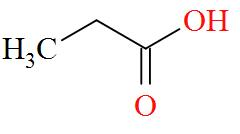
As per the definition, no carbon atom in propanoic acid is seen to be bonded to four different atoms or groups of atoms. Hence, propanoic acid is optically inactive in nature.
Option B mentions the compound $\text{HOOC - C}{{\text{H}}_{\text{2}}}\text{- COOH}$ also known as Malonic acid has a molecular structure of,
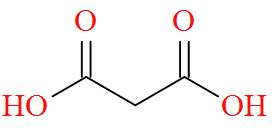
As per the definition, no carbon atom in Malonic acid is seen to be bonded to four different atoms or groups of atoms. Hence, Malonic acid is optically inactive in nature.
Option C mentions the compound $\text{C}{{\text{H}}_{\text{3}}}\text{CH(OH)COOH}$ which has an IUPAC name of 2-hydroxypropanoic acid, also known as lactic acid has a molecular structure of,
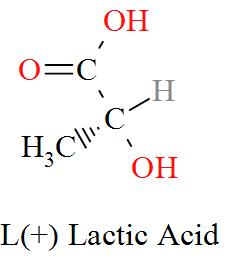
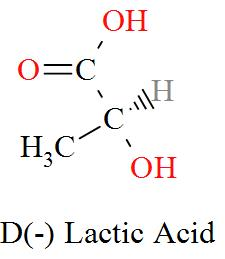
As per the definition, here we can see one carbon atom in Lactic acid is seen to be bonded to four different atoms or groups of atoms forming a Levo and a Dextro structure. Hence, Lactic acid is optically active in nature.
Option D mentions the compound $\text{C}{{\text{l}}_{\text{2}}}\text{CHCOOH}$ which has an IUPAC name of dichloroacetic acid has a molecular structure of,
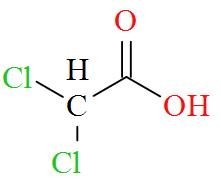
As per the definition, no carbon atom in dichloroacetic acid is seen to be bonded to four different atoms or groups of atoms. Hence, dichloroacetic acid is optically inactive in nature.
Therefore, the correct option is Option C.
Note: Therefore, we can say that chiral molecules are optically active, which implies that when a beam of plane polarized light passes through a chiral molecule. This will make sure that it interacts with the molecule in such a way that the angle of the plane of oscillation rotates.
Complete step by step answer:
Option A mentions the compound $\text{C}{{\text{H}}_{3}}\text{C}{{\text{H}}_{\text{2}}}\text{COOH}$ which has an IUPAC name of propanoic acid has a molecular structure of,

As per the definition, no carbon atom in propanoic acid is seen to be bonded to four different atoms or groups of atoms. Hence, propanoic acid is optically inactive in nature.
Option B mentions the compound $\text{HOOC - C}{{\text{H}}_{\text{2}}}\text{- COOH}$ also known as Malonic acid has a molecular structure of,

As per the definition, no carbon atom in Malonic acid is seen to be bonded to four different atoms or groups of atoms. Hence, Malonic acid is optically inactive in nature.
Option C mentions the compound $\text{C}{{\text{H}}_{\text{3}}}\text{CH(OH)COOH}$ which has an IUPAC name of 2-hydroxypropanoic acid, also known as lactic acid has a molecular structure of,


As per the definition, here we can see one carbon atom in Lactic acid is seen to be bonded to four different atoms or groups of atoms forming a Levo and a Dextro structure. Hence, Lactic acid is optically active in nature.
Option D mentions the compound $\text{C}{{\text{l}}_{\text{2}}}\text{CHCOOH}$ which has an IUPAC name of dichloroacetic acid has a molecular structure of,

As per the definition, no carbon atom in dichloroacetic acid is seen to be bonded to four different atoms or groups of atoms. Hence, dichloroacetic acid is optically inactive in nature.
Therefore, the correct option is Option C.
Note: Therefore, we can say that chiral molecules are optically active, which implies that when a beam of plane polarized light passes through a chiral molecule. This will make sure that it interacts with the molecule in such a way that the angle of the plane of oscillation rotates.
Recently Updated Pages
Why are manures considered better than fertilizers class 11 biology CBSE

Find the coordinates of the midpoint of the line segment class 11 maths CBSE

Distinguish between static friction limiting friction class 11 physics CBSE

The Chairman of the constituent Assembly was A Jawaharlal class 11 social science CBSE

The first National Commission on Labour NCL submitted class 11 social science CBSE

Number of all subshell of n + l 7 is A 4 B 5 C 6 D class 11 chemistry CBSE

Trending doubts
10 examples of friction in our daily life

One Metric ton is equal to kg A 10000 B 1000 C 100 class 11 physics CBSE

Difference Between Prokaryotic Cells and Eukaryotic Cells

1 Quintal is equal to a 110 kg b 10 kg c 100kg d 1000 class 11 physics CBSE

State the laws of reflection of light

Explain zero factorial class 11 maths CBSE




